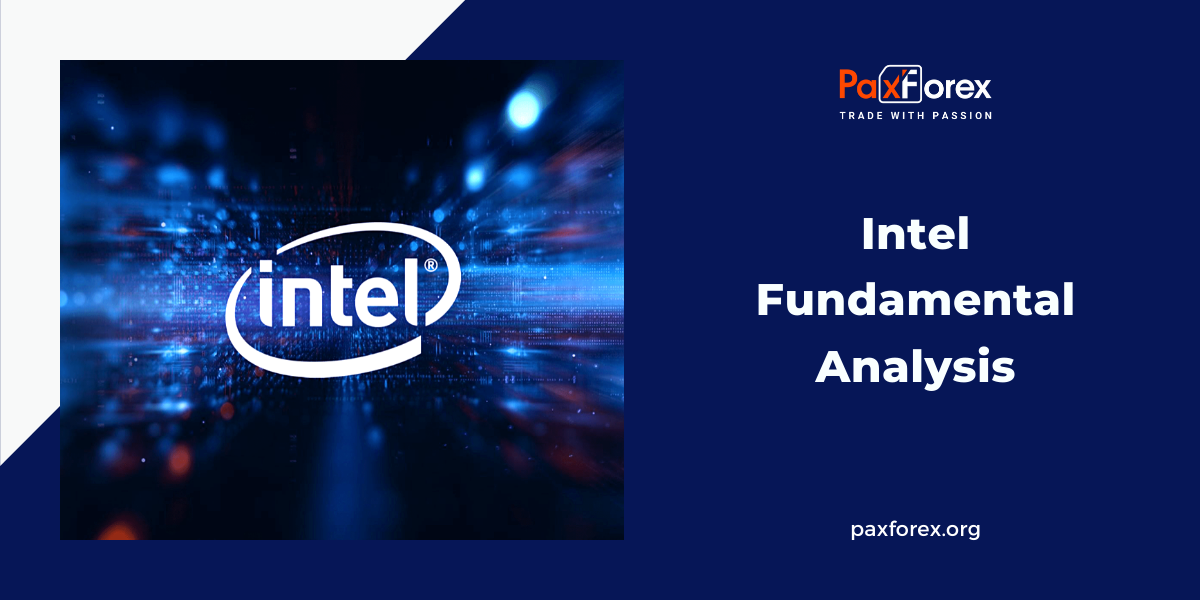
Source: PaxForex Premium Analytics Portal, Fundamental Insight
Intel is one of the largest chip makers in the world and one of the leaders in the semiconductor industry. Most investors probably know that the company is the largest maker of x86 processors for PCs and servers, but in recent years it has also experienced errors in research and development and delays in production.
Those mistakes have caused the company to fall behind Taiwan Semiconductor Manufacturing, or TSMC, in the technology race to produce smaller, denser, and more energy-efficient chips. They have also allowed Advanced Micro Devices, its competitor, which outsources its production to TSMC, to pull ahead with more advanced chips.
Intel is again trying to catch up with TSMC by expanding its factories and upgrading technology, but critics believe its last-minute efforts will fail and lead to an existential crisis for the company. Bulls believe that government subsidies, especially the pending CHIPS Act, can save Intel.
We have covered these arguments in the past, but today we will focus on three lesser-known facts that have changed Intel's past and could affect its future.
- Intel once developed ARM-based chips
Intel's biggest mistake was probably its failure to extend its leadership in PC and data center processors to the mobile chip market. It lost that market because x86 processors consumed too much power for small mobile devices that prioritized low power consumption over raw processing power.
This shift in market demand led to ARM, a British chip developer that was eventually bought by SoftBank in 2016. ARM licensed its energy-efficient designs to a wide range of chip makers, including Qualcomm and Apple, which led to the conquest of the smartphone market. Today, more than 95 percent of premium smartphones are powered by ARM processors.
Intel briefly tried to challenge ARM with its less powerful x86 Atom processors for mobile devices, but those chips didn't get much traction -- even after Intel paid original equipment manufacturers billions of dollars to try out its chips.
All of this misery could have been avoided if Intel hadn't made two crucial mistakes. First, it turned down the opportunity to develop a processor for Apple's first iPhone, believing that Apple would never sell enough phones to justify the cost of developing a new mobile chip.
Second, Intel failed to expand xScale, the ARM-based chip maker that grew out of its acquisition of the StrongARM team from DEC in 1998. With proper investment, Intel could have turned xScale into a formidable ARM chipmaker like Qualcomm. Instead, the company sold xScale to Marvell in 2006 and focused on Atom. Intel is still suffering the consequences of those two mistakes today.
- Intel is abandoning the memory chip market
Intel is widely known as a processor manufacturer, but for decades it has also produced memory chips. Back in 1985, Intel abandoned the DRAM market amid stiff competition from Japanese chipmakers.
In 1988, however, Intel continued to develop flash memory chips. In recent years, the company collaborated with Micron Technology, one of the world's leading memory chip makers, to jointly develop a new generation of 3D XPoint memory chips for high-end SSDs.
But in 2020, Intel announced it would sell its NAND business to South Korean memory chip maker SK Hynix for $9 billion. Intel will retain the Optane segment, where its smaller 3D XPoint business is located.
The sale will take place in several stages and will be completed in the first quarter of 2025. Until then, Intel will exclude its NAND business from its non-GAAP (generally accepted accounting principles) revenue and earnings.
Intel likely backed out of the NAND market because it was a far outsider compared to market leaders such as Samsung and SK Hynix, and selling the business would free up more cash to expand its core processor business.
- Intel outsources its chips to TSMC
Intel talks a lot about catching up with TSMC and bringing chip production back to the U.S. by 2025, but it's actually outsourcing some of its chip production to TSMC foundries.
Last year, Intel already turned over the production of its discrete graphics processors to TSMC. It also intends to give TSMC some of its upcoming 3nm and 5nm processors, which are likely to be available in 2023. Intel will still produce most of its own chips, but this strange partnership shows that the company can't turn its business around without relying on its biggest competitor.
Intel's missteps in mobile devices and its exit from the memory chip market show how difficult it is for the company to consistently go beyond its core x86 processor market. That's why the company is also looking to highlight Mobileye, the automotive chip maker it acquired in 2017, in its upcoming initial public offering.
CEO Pat Gelsinger, who took over the company last February, understands that the aging chipmaker needs to double production to stay relevant. But his outsourcing deals with TSMC -- which he made even when Gelsinger publicly stated that Taiwan "is not a stable place" for chip production -- show how far behind he already is and how important the next few years will be.
As long as the price is above the 39.00 level, follow the recommendations below:
- Time frame: D1
- Recommendation:long position
- Entry point:39.10
- Take Profit 1: 42.50
- Take Profit 2: 50.00
Alternative scenario:
If the level of 39.00 is broken-down, follow the recommendations below:
- Time frame: D1
- Recommendation: short position
- Entry point: 39.00
- Take Profit 1: 37.00
- Take Profit 2: 35.50













